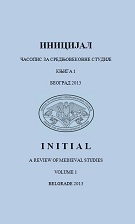Карта као извор за поглавља 29−36 списа De administrando imperio
The Map as an Information Source for Chapters 29-36 of De Administrando Imperio
Author(s): Bojan NovakovićSubject(s): History
Published by: Центар за напредне средњовековне студије
Keywords: De administrando imperio; cartographic representation of South Slavic lands; merged geographic names; „christened“ Serbia; „Hum Mountain“; hora; horion
Summary/Abstract: The article analyses the origins of geographic information contained in chapters 29–36 of De administrando imperio, an instruction in statesmanship written by Byzantine emperor Constantine VII Porphyrogenitus (945–959). Names given for certain Adriatic islands in chapter 29 (Καταυτρεβενώ, Σκηρδάκισσα and Ἐστιουνὴζ) are in fact all composed by merging names of different islands lying close to each other, indicating that this information was copied from a map. The same applies to the name Λοντοδóκλα from chapter 35, where we have a combination of a Slavic city name (Lug) with the name of a nearby deserted ancient city (Doclea). The mountain of Hum with two cities on it, mentioned in chapter 33, is a misconception resulting from a mapreading error – Porphyrogenitus knew that the Slavic word hum means hill and interpreted the cartographic representation of the medieval principality of Hum and its two major cities as a mountain. The above examples may have their origins in different maps dating from different periods. South Slavic principalities and tribes are listed in an order that reflects their political status – those that were ruled by Serbia are placed immediately following it – with differences in that status denoted by the terms hora, horion and archontia. This order served as the basis for the division of the text into chapters, and Porphyrogenitus observed it in all his works.
Journal: Иницијал. Часопис за средњовековне студије
- Issue Year: 2013
- Issue No: 1
- Page Range: 33-48
- Page Count: 16
- Language: Serbian

